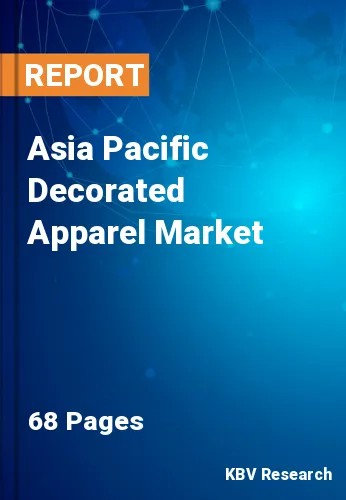The Asia Pacific Decorated Apparel Market would witness market growth of 12.5% CAGR during the forecast period (2022-2028).
Using various forms of tailored materials, digital printing technology aids in the creation of decorated apparel garments. With the application of high temperatures, the solid printing ink is directly turned into gas and deposited on the appropriate garments to form a strong relationship with the fibers. It is now feasible to simplify the process of printing high-quality color prints and pictures onto fabrics and textiles using decorated apparel. It is considered sustainable, as opposed to traditional printing procedures, and gives greater photographic resolution with brilliant colors, resistance to cracking, peeling, or fading, and long-lasting coloration to the exposed surface. Furthermore, decorated apparel is a printing technique that uses ink and heat to create a design on fabric. A specific sort of ink known as dispersion dyes is utilized in this procedure, which is inserted into the fabric rather than printed on top of it.
There are thousands of distinct standards for clothing, apparel, and footwear sold in China, each with its own quality and safety criteria. The standards include manufacturing criteria such as inspection, craftsmanship rules, and product performance testing. In each product standard, there are three quality levels: qualified, first, and high-class. The quality guarantee stated on the product label is implied by the product standard. The lowest quality grade for the standard should be met, and the quality grade shall be disclosed on the product hangtag together with the product standard.
Many Chinese regulatory bodies also publish regulations for products marketed in China. Companies can seek advice from their exporter or dealer, the applicable Chinese trade association, or their test lab or supervisory board to identify and receive copies of necessary technical rules.
China customs officials may reject products without a Qualified Certificate and valid PASS test reports that meet the requirements of statutory national GB standards and defined expert standards, or with unacceptable test findings. There are no certification standards for textile and garment products imported for sale in China, with the exception of certain protective gear and home furnishing materials.
The China market dominated the Asia Pacific Decorated Apparel Market by Country in 2021, and would continue to be a dominant market till 2028; thereby, achieving a market value of $5,361.6 million by 2028. The Japan market is poised to grow at a CAGR of 11.8% during (2022 - 2028). Additionally, The India market would display a CAGR of 13.2% during (2022 - 2028).
Based on Product, the market is segmented into Embroidery, Screen Printing, Dye Sublimation, Digital Printing, and Others. Based on End Users, the market is segmented into Women, Men, and Children. Based on countries, the market is segmented into China, Japan, India, South Korea, Singapore, Malaysia, and Rest of Asia Pacific.
Free Valuable Insights: The Worldwide Decorated Apparel Market is Projected to reach USD 52.8 Billion by 2028, at a CAGR of 12.1%
The market research report covers the analysis of key stake holders of the market. Key companies profiled in the report include Fruit of The Loom, Inc. (Berkshire Hathaway Inc.), Downtown Custom Printwear, Delta Apparel, Inc., Target Decorated Apparel, Advance Printwear Ltd., Lynka sp. z.o.o. (Vantage Custom Classics, Inc.), Gildan Activewear Inc., HanesBrands Inc., and Master Printwear.
By Product
By End Users
By Country
Our team of dedicated experts can provide you with attractive expansion opportunities for your business.

